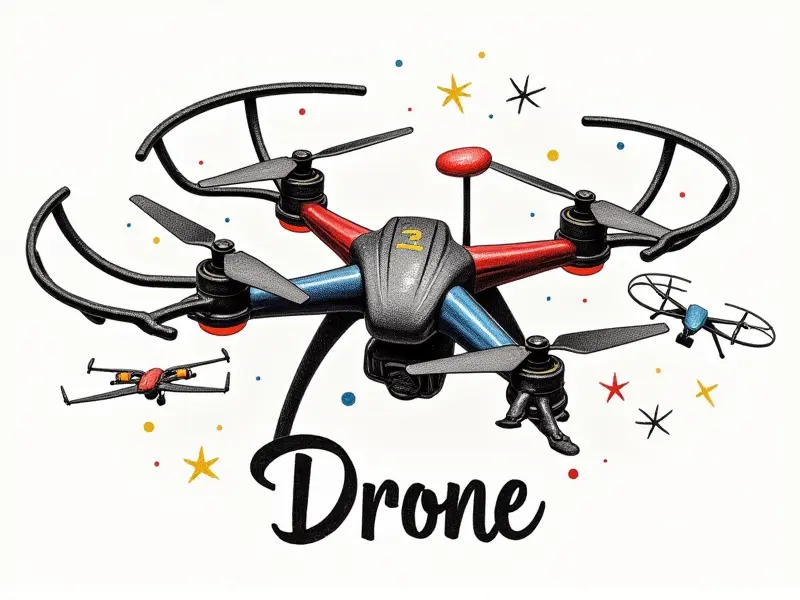Drone propeller selection

Choosing the Right Propellers for Your Drone
Selecting the right propellers is crucial to achieving optimal performance from your drone. The type and size of propellers you choose can significantly affect flight time, speed, stability, and overall efficiency. This guide will help you understand the key factors involved in choosing the best propellers for your specific needs.
Optimal Propellers for FPV Racing Drones
FPV racing drones require a balance between high-speed performance and maneuverability. Optimal propeller choices for these applications often involve smaller diameters with higher pitch to achieve maximum velocity without compromising agility. Common sizes range from 5030 to 6045, depending on the frame size and motor capabilities.
Understanding Drone Propeller Sizes
The sizing of drone propellers is typically denoted in inches or millimeters (e.g., 10x4.7). The first number represents the diameter while the second indicates the pitch. A larger diameter generally provides more lift, whereas a higher pitch allows for greater speed and efficiency at altitude.
Common Propeller Sizes
- 5-inch: Ideal for micro drones and FPV racing due to their compact size and high-speed capabilities.
- 7-inch: Suitable for medium-sized drones offering a good balance between speed, agility, and lift capacity.
- 10-inch: Best suited for large drones requiring significant lift and payload capacity.
Maximize Flight Time with Perfect Props
To extend your drone's flight time, consider using propellers that offer the best balance between efficiency and thrust. A higher pitch can reduce power consumption at cruising altitude but may require more torque during takeoff. Experimenting with different sizes and pitches will help you find the optimal configuration for maximum endurance.
Balancing Speed and Stability in Props
Propeller design plays a critical role in balancing speed and stability. Propellers designed for high-speed applications tend to have lower blade counts (e.g., 3-blade) to reduce drag, while those prioritizing stability often feature more blades (e.g., 4 or 5-blade) to distribute lift evenly across the surface area.
Essential Factors in Drone Propeller Choice
Several factors should be considered when selecting propellers:
- Drone Type: Recreational, racing, or professional applications each have unique requirements regarding speed, stability, and payload.
- Motor Specifications: The power output of your motors will dictate the appropriate size and pitch range for optimal performance.
- Frame Design: Larger frames may require larger propellers to maintain lift capacity and maneuverability.
The Best Props for Your Drone
Selecting the best propellers involves matching them with your drone’s specific characteristics. For instance, a high-performance racing quadcopter might benefit from lightweight carbon fiber propellers designed for speed, whereas a camera-equipped aerial photography drone would likely perform better with sturdier plastic props optimized for stability and durability.
Boost Performance with Top Props
To enhance your drone's performance, consider upgrading to premium propeller materials such as carbon fiber or titanium. These materials offer superior strength-to-weight ratios compared to standard plastics, enabling faster speeds and smoother flights without compromising structural integrity.
Propeller Impact on Drone Stability & Speed
The choice of propellers directly influences both the stability and speed of your drone. Propellers with higher pitch provide better forward thrust but may sacrifice lift efficiency at lower altitudes. Conversely, wider diameter props offer greater lifting capacity but can add more resistance during high-speed maneuvers.
Propeller Types
- Tri-blade: Offers a good compromise between speed and stability.
- Quad-blade: Provides excellent lift and stability, ideal for heavy payloads or windy conditions.
- Penta-blade: Designed for maximum stability at the expense of some speed.
Budget-Friendly Propellers for Beginners
If you're new to drone flying, starting with budget-friendly propellers is a practical choice. Many entry-level drones come equipped with reliable plastic props that offer adequate performance and durability without breaking the bank. As your skills improve, you can gradually upgrade to more specialized propeller types.
Conclusion
Selecting the right propellers for your drone involves considering various factors such as drone type, motor specifications, frame design, and intended use case. By understanding these elements and experimenting with different propeller sizes and materials, you can significantly enhance your drone's performance in terms of speed, stability, and flight time.

